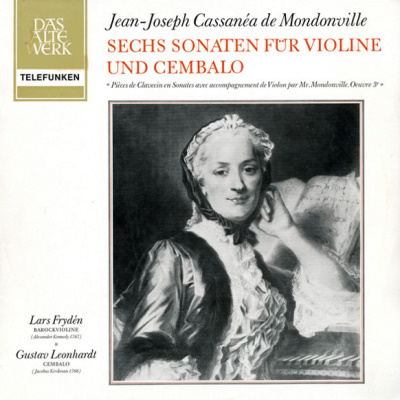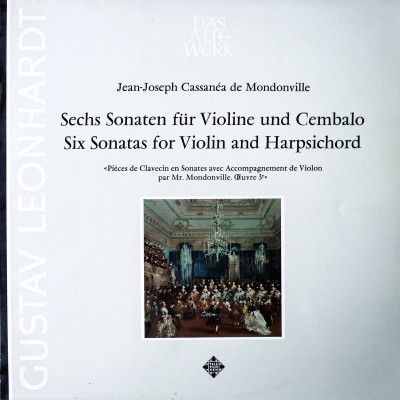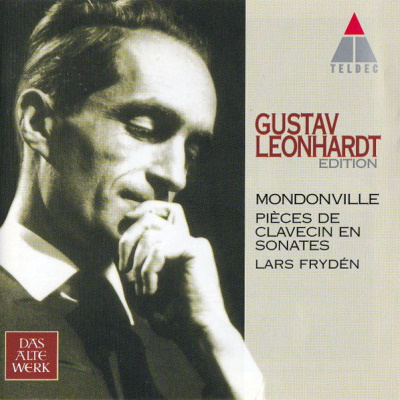 |
|
1 LP -
SAWT 9497-B - (p) 1966
|
 |
| 1 LP -
6.41071 AS (SAWT 9497-B) - (p) 1966 |
 |
| 1 CD -
3984-21765-2 - (c) 1998 |
|
| PIÈCES DE
CLAVECIN EN SONATES - Oeuvre 3, Paris
etwa 1734 |
|
|
|
|
|
|
|
| Jean-Joseph
Cassanéa de MONDONVILLE (1711-1772) |
Sonate
Nr. 1 g-moll |
|
6' 45" |
A1 |
|
-
(Ouverture · Aria · Giga)
|
|
|
|
|
Sonate
Nr. 3 B-dur |
|
6' 22" |
A2
|
|
-
(Allegro · Aria · Allegro) |
|
|
|
|
Sonate Nr. 4 C-dur |
|
11' 00" |
A3 |
|
-
(Allegro · Aria · Giga) |
|
|
|
|
Sonate
Nr. 5 G-dur |
|
5' 42" |
B1 |
|
-
(Allegro · Aria · Allegro) |
|
|
|
|
Sonate
Nr. 2 F-dur
|
|
5' 43" |
B2 |
|
-
(Allegro · Aria · Giga) |
|
|
|
|
Sonate
Nr. 6 A-dur |
|
11' 00" |
B3 |
|
-
(Concerto · Larghetto · Giga) |
|
|
|
|
|
|
|
|
Lars
FRYDÉN, Barock violine
(Alexander Kennedy, London 1767)
Gustav LEONHARDT, Cembalo
(Jacobus Kirckman, London 1766
Beide Instrumente in Barockmensur.
Stimmung ein Halbton unter normal
|
|
|
|
|
|
Luogo
e data di registrazione |
|
(luogo di
registrazione non indicato) - 1966
|
|
|
Registrazione: live
/ studio |
|
studio |
|
|
Producer |
|
-
|
|
|
Prima Edizione LP |
|
Telefunken "Das Alte
Werk" | SAWT 9497-B (Stereo) - AWT
9497-C (Mono) | 1 LP - durata 47'
06" | (p) 1966 | ANA
Telefunken
"Das Alte Werk" | 6.41071 AS
(SAWT 9497-B) | 1 LP - durata
47' 06" | (p) 1966 | ANA |
Riedizione |
|
-2
|
Edizione CD |
|
Teldec Classics |
LC 6019 | 3984-21765-2 | 1 CD -
durata 47' 06" | (c) 1998 | ADD
|
|
|
Cover
|
|
"Md. de Mondonville
am Klavier", Gemälde von Maurice
Quentin de la Tour.
|
|
|
Note |
|
-
|
|
|
|
|
Among the
composers who, through their
performing and writing, won
a leading place for the
violin alongside the
harpsichord in French
chamber music of the first
halft of the 18th
century, Jean Joseph
Cassanéa de
Mondonville occupies
an honourable place. Born at
Narbonne in 1711, he already
made his voice heard in
Paris in 1733 with his
"Sonates pour le Violon Op.
1", and in 1734 he made his
début as a violinist "d'une
manière très brillante" at
the Concert Spirituel, the
trend-setting public concert
of the metropolis. He also
won success very soon as a
composer of church music. In
1738 the management of the
Concerts Spirituels offered
him a fixed annual salary of
1200 livres "pour ses motets
et pour jouer le Violon,"
and he performed together
with his most important
rivals, the violin virtuosi
and composers Guignon and
Guillemain. In 1748 he
joined the management of the
Concerts Spirituels, he was
their organizer and
conductor 1755-1762 and, in
addition, "Administrator" of
the Court Orchestra
1745-1758 - all in all, a
key figure for decades in
Parisian musicall life and a
celebrated and
self-confident master, also
in the fields of opera and
church music.
Mondonville's output
faithfully reflects the
changing fashions of
Parisian musical life
between 1730 and 1770. At
the beginning of his career
there stand, alongside some
lost violon concertos, the
great, partly pioneering
chamber music works: the
Violin Sonatas Op. 1 (1733),
the Trio Sonatas Op. 2
(1734), the "Pièces de
Clavecin en Sonates avec
Accompagnement de Violon Op.
3" (ca. 1734), the Violin
Sonatas with Continuo Op. 4
(ca. 1735) and the "Pièces
de Clavecin avec Voix ou
Violon Op. 5" (1748). After
this, Mondonville's chamber
music composition ceases
abruptly; instead, church
music occupies the central
place in his activities
until well into the fifties,
and in the degree to which
the opera held Paris in
suspense with the impending
revolution of the "tragédie
lyrique" through Gluck,
composition for the stage
also came to the fore. In
the last decades of his
life, Mondonville wrote
exclusively for the Paris
opera.
The decisive historical and
artistic achievements of
this composer are, however,
not his operas but his early
chamber music works, above
all the violin sonatas. It
was they that established
his fame in Paris, being
played, listened to and
discussed at all the focal
points of the capital's
musical life. Mondonville at
once found the idiom best
suited to the Parisian
cultivation of chamber
music, with its combination
of social brilliance,
cultured entertainment and
soundness of knowledge. The
Violin Sonatas Op. 1 already
display his characteristic
style - the easy, playful
and elegant blend of
graceful rococo melody,
soundness and delicacy of
technique, select, subtle
and distinctively surprising
harmony and brilliant
writing for the violin. In
the later works an
experimental spirit and a
delight in technical
problems come more into the
foreground without
disturbing the charm of the
general impression. Here, as
everywhere else in
mondonville's works, the
spirit of 18th century
France has assumed musical
shape in the most graceful
manner, and it is this,
independently of any
historical signifcance of
the works, that lends them
their undimished freshness
and attractiveness.
The six "Pièces en Sonates"
on our record (Op. 3, ca.
1734) mark the beginning of
a new type of composition in
France: the "classical"
piano-violin sonata in which
the two instruments play
together on an equal footing
and an 'obligato' basis.
They differ from Bach's
violin sonatas in the free
part-writing and
'concertante' character of
their structure, from the
earlier baroque violin
sonata in freeing themselves
from the continuo and
transferring the forms and
techniques of the French
harpsichord piece to the
ensemble sonata. In this
combination of violin sonata
and harpsichord piece,
Mondonville has thoroughly
exploited all the possible
combinations, shadings and
instrumental techniques that
there was hardly anything
left for his successors to
do. This is all the more
true in that his blending of
types corresponds
stylistically to an equally
logical combination of
French and Italian idioms
and forms from the
miniature-like Parisian
clavecin-pièce to the
Italian concerto à la
Vivaldi. around 1734
Mondonville's sonatas stand
solitary in a fertile but
still fallow field.
At a first glance, their
form is consistently that of
an Italian concerto:
Allegro, aria und Allegro,
the latter usually
designated as Giga. However,
behind the neutral term
Aria, there hide a wide
variety of slow movement
models, and the first and
last sonatas are thrown into
relief as "French" and
"Italian" prototypes: the
first by a French overture
as its opening movement, the
last as an Italian concerto
with "tutti" and "soli."
Thus the elements
ingeniously and
entertainingly blended in
the rest of the sonatas of
the series are introduced
programmatically at the
beginning and the end. The
wit, elegance and
cosmopolitan spirit of the
early "dixhuitième" have
seldom entered works of
musical art more
authentically.
Ludwig
Finscher
|
  |
|
|